17 Must-Have Vegetables for Your Backyard Garden
Tag Heuer replica Backyard vegetable gardens are a fantastic way to grow your own fresh produce right at home. Not only do they provide delicious fruits and veggies, but they also add a touch of greenery to your outdoor space and can be a calming hobby. Whether you’re a seasoned gardener or just starting, setting up a garden can be simple and rewarding!
Soil Preparation Techniques for Healthy Growth
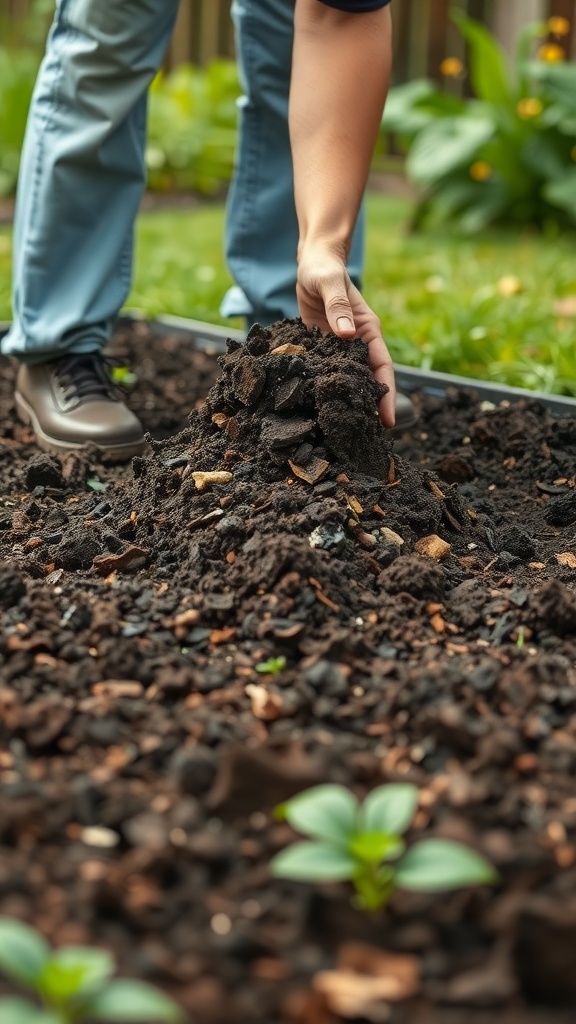
Preparing the soil is a key step for a thriving backyard vegetable garden. The image shows someone working the soil, which is rich and dark, indicating good health. This is where it all begins!
Start by removing any weeds or debris from your garden bed. This helps prevent competition for nutrients. Next, consider replica Rolex day-date adding organic matter like compost or well-rotted manure. This boosts soil fertility and improves texture.
Replica Uhren Mixing in these materials is essential. The person in the image is doing just that, ensuring the soil is well-aerated. This allows roots to grow freely and access water and nutrients easily.
Don’t forget to test your soil’s pH. Most vegetables thrive in slightly acidic to neutral soil. If your soil is too acidic or alkaline, you can amend it with lime or sulfur accordingly.
Finally, let your soil rest for a bit after preparation. This allows beneficial microorganisms to flourish, setting the stage for healthy plant growth. With these techniques, your backyard garden will be off to a great start!
Companion Planting for Pest Control
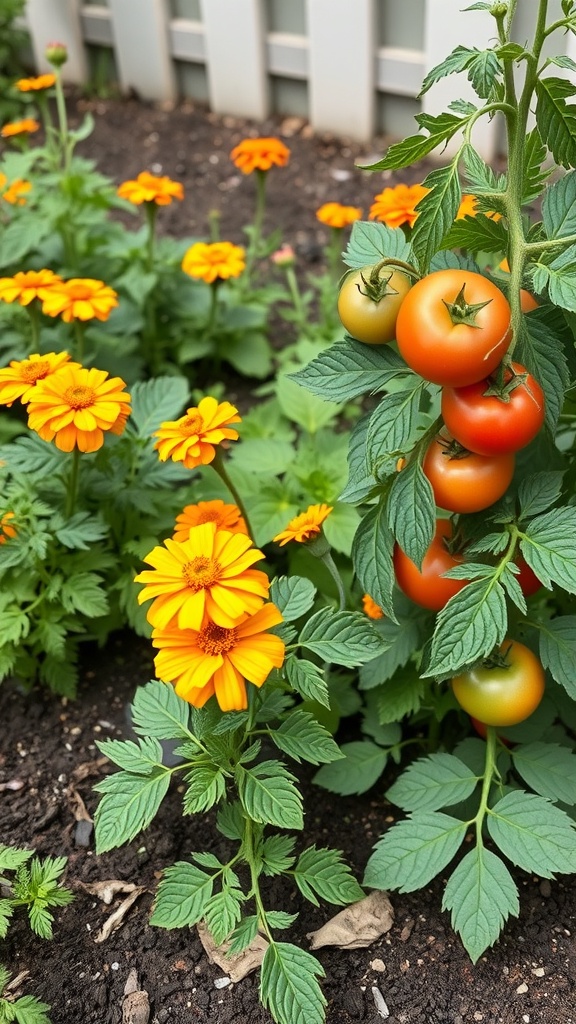
In a backyard vegetable garden, companion planting is a smart way to keep pests at bay. The image shows vibrant marigolds blooming alongside a healthy tomato plant. Marigolds are known for their ability to repel harmful insects, making them a perfect partner for tomatoes.
Planting marigolds near tomatoes not only enhances the garden’s beauty but also serves a practical purpose. The bright orange flowers attract beneficial insects, which help control pests. This natural pest control method reduces the need for chemical pesticides, promoting a healthier garden.
When planning your garden, think about which plants work well together. For example, basil is another great companion for tomatoes. It can improve flavor and also deter pests. By mixing different plants, you create a balanced ecosystem that supports growth and keeps unwanted visitors away.
Essential Tools for Backyard Gardening
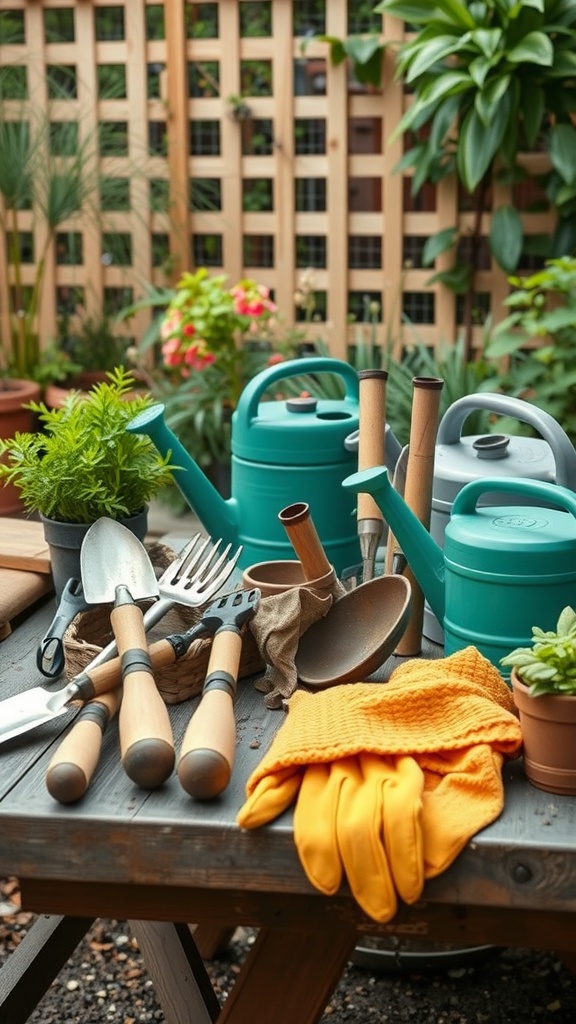
Starting a backyard vegetable garden is exciting, and having the right tools makes all the difference. In the image, you can see a variety of essential gardening tools laid out on a rustic wooden table. These tools are not just functional; they also add a touch of charm to your gardening space.
First up are the watering cans. The bright teal color stands out and shows that watering your plants can be a fun task. Keeping your plants hydrated is key to a thriving garden. Next to them, you’ll find a set of hand tools, including a trowel and a cultivator. These tools help you dig, plant, and aerate the soil, making it easier for your veggies to grow.
Don’t overlook the gloves! The bright orange pair in the image is perfect for protecting your hands while you work. Gardening can be tough on your skin, so a good pair of gloves is a must. The small pots with greenery also hint at the joy of starting seedlings, which is a rewarding part of gardening.
Lastly, the overall setup shows a well-organized gardening space. Having your tools at hand makes the gardening process smoother and more enjoyable. So, gather your tools, and get ready to dig into your backyard gardening journey!
Selecting the Best Vegetables for Your Climate
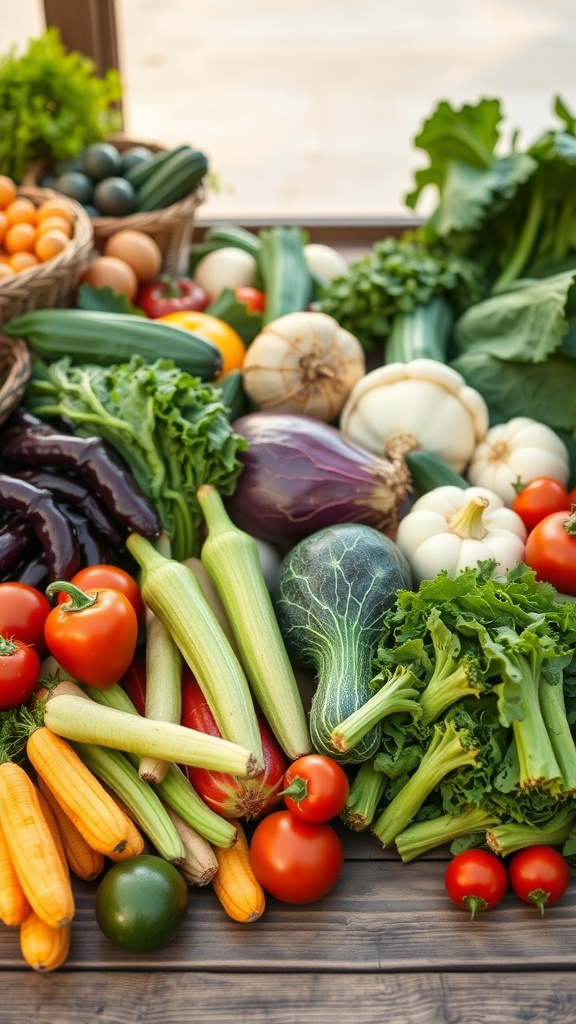
Growing a backyard vegetable garden is a rewarding experience. The first step is picking the right vegetables for your climate. The image shows a colorful array of fresh vegetables, each thriving in its own season. From tomatoes and zucchini to leafy greens, these choices can flourish in various conditions.
Consider your local climate. Some vegetables love the heat, while others prefer cooler temperatures. For instance, tomatoes and peppers thrive in warm weather, making them perfect for summer gardens. On the other hand, leafy greens like lettuce and spinach do better in cooler months.
It’s also helpful to think about your growing season. If you have a shorter season, opt for fast-growing varieties. Radishes and bush beans are great options that mature quickly. This way, you can enjoy fresh produce even if your growing time is limited.
Lastly, don’t forget about your personal preferences. Choose vegetables you and your family enjoy eating. This makes gardening even more fun and rewarding. With the right selections, your backyard can become a vibrant source of fresh ingredients.
Organic Pest Management Solutions
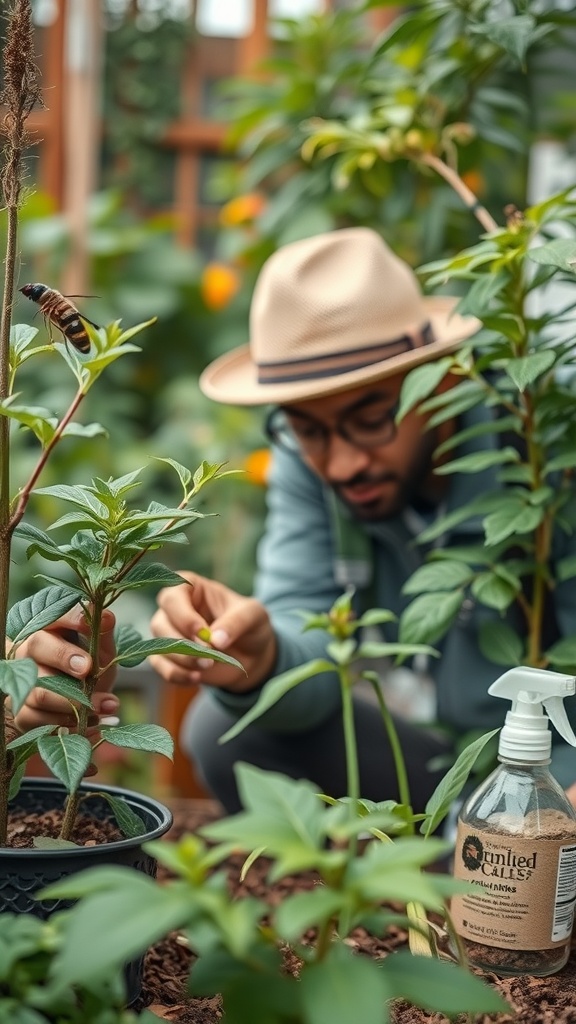
In a backyard vegetable garden, keeping plants healthy is key. The image shows a person carefully inspecting plants, which is a great practice for organic pest management. This hands-on approach helps catch any issues early.
Using natural solutions is a smart way to protect your garden. The person in the image has a spray bottle, likely filled with an organic pest control solution. These sprays can deter pests without harming beneficial insects.
Another effective method is introducing beneficial insects. Ladybugs and lacewings can help keep pest populations in check. Creating a welcoming environment for these helpers can make a big difference.
Regularly checking your plants, like the person in the image, allows you to spot any signs of trouble. Look for holes in leaves or any unusual spots. Early detection means you can act quickly, keeping your garden thriving.
Seasonal Planting Guide for Backyard Gardens
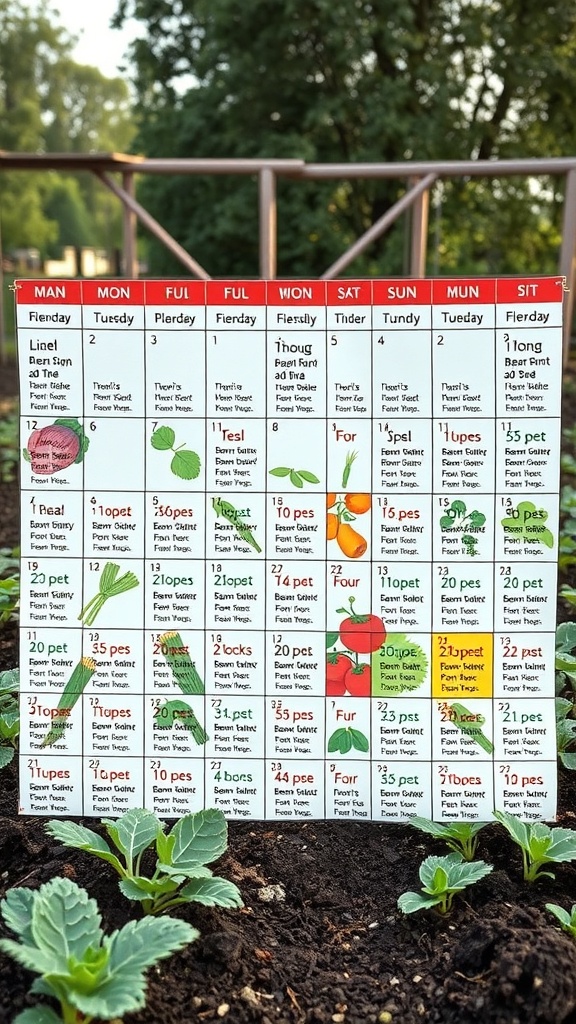
Planning a backyard vegetable garden can be a fun and rewarding experience. The image shows a planting calendar, which is a handy tool for any gardener. It lays out what to plant each month, helping you stay organized and on track.
Each section of the calendar highlights different vegetables and their ideal planting times. For instance, you can see when to plant leafy greens, root vegetables, and more. This guide is perfect for beginners and seasoned gardeners alike, making it easy to rotate crops and maximize your harvest.
Using a planting calendar helps you understand the seasons better. It shows when to start seeds indoors and when to transplant them outside. This ensures your plants get the right conditions to thrive. With this knowledge, you can enjoy fresh veggies throughout the growing season.
So, grab your gardening tools and get ready to dig in! With a little planning and care, your backyard can turn into a bountiful vegetable garden.
Choosing the Right Location for Your Garden

Picking the right spot for your backyard vegetable garden is key to its success. The image shows a sunny yard with raised garden beds, perfect for growing a variety of vegetables. Sunlight is essential, so look for an area that gets at least six hours of direct sunlight each day.
Notice how the garden beds are positioned in a way that maximizes light exposure. This setup not only helps the plants thrive but also makes it easier to tend to them. Avoid areas with too much shade from trees or buildings, as this can hinder growth.
Also, consider the soil quality. The ground in the image appears well-maintained, which is important for healthy plants. If your soil isn’t great, you might want to use raised beds like those shown. They allow for better soil control and drainage.
Lastly, think about accessibility. You want to be able to reach your plants easily for watering and harvesting. The layout in the image shows clear paths, making it simple to care for the garden. A well-chosen location will make your gardening experience enjoyable and productive.
Harvesting Techniques for Maximum Yield
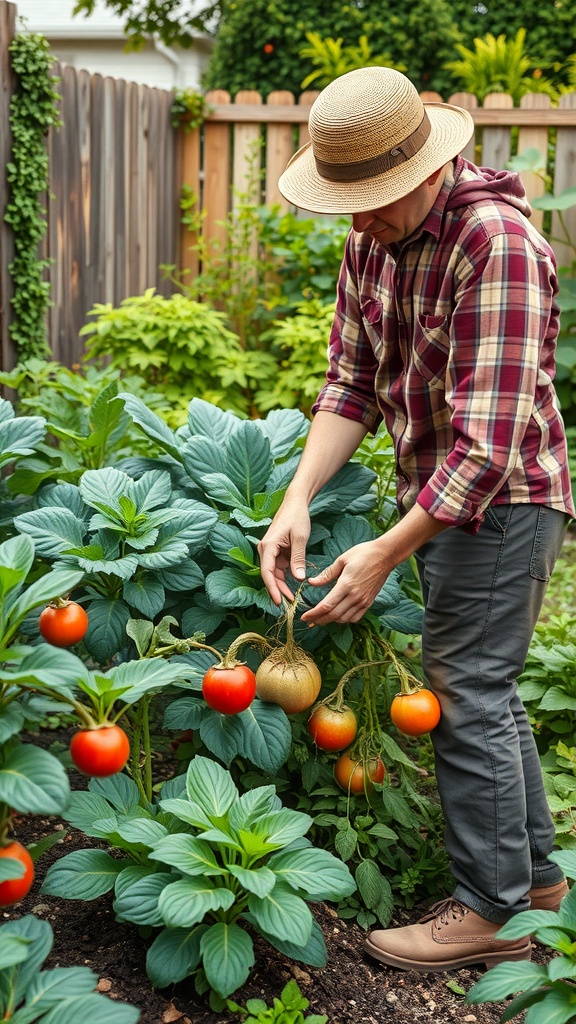
Harvesting your backyard vegetable garden can be a rewarding experience. In the image, we see a gardener carefully picking ripe tomatoes and a pumpkin. This moment captures the joy of gathering fresh produce right from your own yard.
To get the most out of your harvest, timing is key. Vegetables should be picked when they are fully ripe. For tomatoes, look for a deep color and slight softness. Pumpkins should have a hard skin and a rich color. Picking at the right time ensures the best flavor and texture.
Using the right tools can make harvesting easier. A pair of garden scissors or shears can help you cut vegetables cleanly without damaging the plants. Always handle your produce gently to avoid bruising.
Don’t forget to check your plants regularly. Some vegetables, like zucchini, can grow quickly and need to be harvested often. Regular picking encourages more growth, leading to a bigger yield.
Lastly, consider using a basket to collect your harvest. This keeps your vegetables safe and makes it easier to carry them inside. Enjoy the fruits of your labor and maybe even share with friends and family!
Vertical Gardening Ideas for Small Spaces
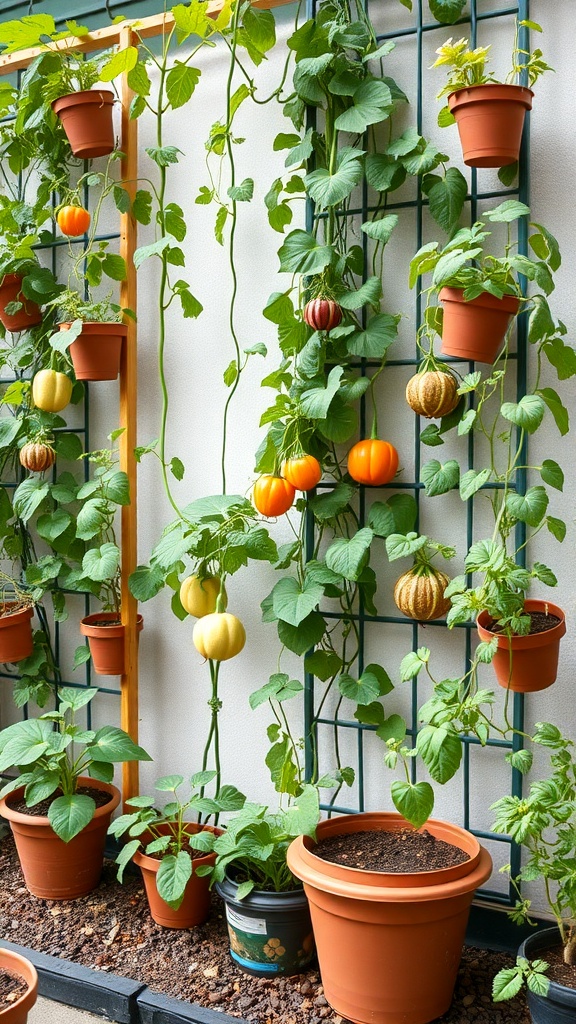
Vertical gardening is a fantastic way to maximize space, especially in smaller backyards. The image shows a creative setup where plants are climbing up a trellis, with pots neatly arranged at different heights. This method not only saves ground space but also adds visual interest to your garden.
In this setup, you can see various types of squash and pumpkins, showcasing how vertical gardening can support larger plants. Using pots allows for easy mobility and customization. You can mix and match different plants to create a colorful display.
Consider using a sturdy trellis or wall-mounted planters to get started. This approach makes it easier to tend to your plants and can even improve air circulation. Plus, it’s a great way to showcase your gardening skills!
Creating a Compost System for Sustainability
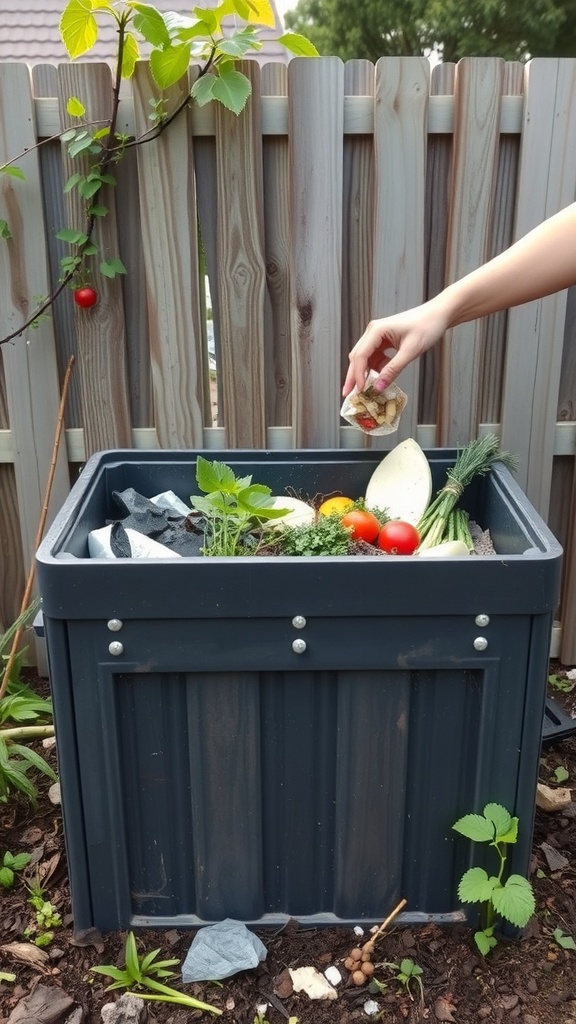
Composting is a fantastic way to recycle kitchen scraps and garden waste. The image shows a compost bin filled with various organic materials. You can see fresh vegetables, herbs, and some paper scraps, all ready to break down into nutrient-rich compost.
Starting a compost system is simple. First, choose a spot in your backyard that gets some sunlight. A compost bin like the one in the image is a great choice. It keeps everything contained and makes it easy to turn the compost.
Next, gather your materials. You can add fruit and vegetable peels, coffee grounds, eggshells, and even yard waste like grass clippings and leaves. Just avoid meat and dairy, as they can attract pests.
Turning your compost regularly helps speed up the process. In a few months, you’ll have rich compost to mix into your vegetable garden. This not only improves soil quality but also reduces waste going to landfills.
So, grab your scraps and start composting! It’s a rewarding way to contribute to a healthier environment while growing your own food.
Planning for Year-Round Gardening
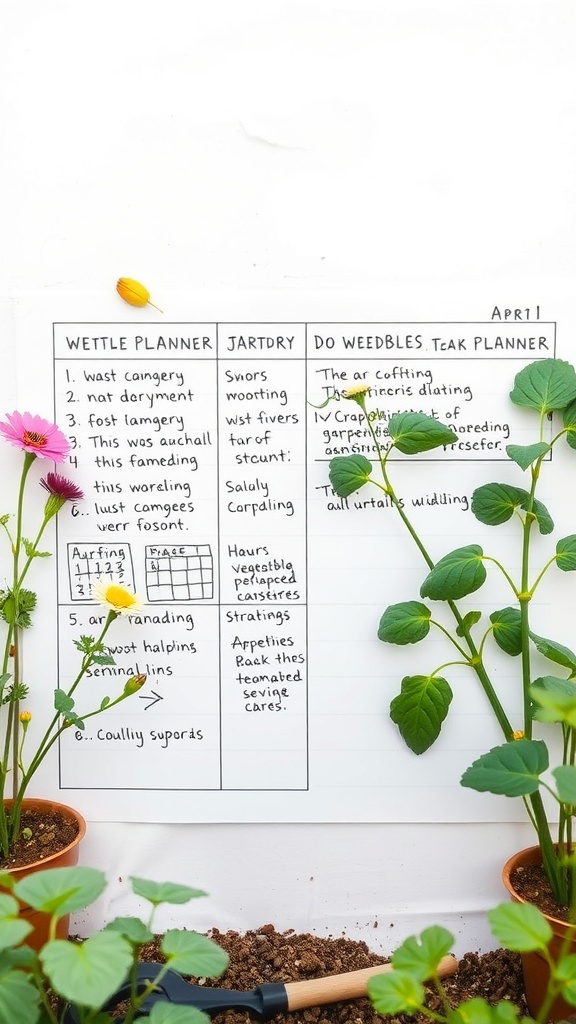
Planning a vegetable garden can be a fun and rewarding experience. The image shows a gardening planner filled with notes and tips for managing a garden throughout the year. Having a clear plan helps you stay organized and ensures you make the most of your gardening efforts.
The planner includes sections for different tasks, like watering schedules and planting dates. This kind of organization is key for year-round gardening. It allows you to track what you’ve planted and when to expect harvests.
Using a planner can also help you rotate crops effectively. This practice keeps your soil healthy and maximizes your harvest. You can jot down ideas for what to plant next and keep track of your successes and challenges.
Incorporating seasonal vegetables into your garden can keep things fresh and exciting. Think about what you enjoy eating and plan accordingly. With a little preparation, you can enjoy fresh veggies from your backyard all year long!
Maintaining a Healthy Garden Ecosystem

In a backyard vegetable garden, a healthy ecosystem is key to thriving plants. The image shows a vibrant mix of plants and beneficial insects, like ladybugs and bees, which play a vital role in pollination and pest control.
These colorful insects help keep harmful pests at bay while promoting the growth of your vegetables. Encouraging such wildlife can lead to a more balanced garden. Planting flowers alongside your veggies attracts these helpful critters.
It’s also important to maintain soil health. Regularly adding compost enriches the soil, providing essential nutrients for your plants. This creates a thriving environment where both plants and insects can flourish.
Watering wisely is another aspect. Too much or too little water can stress plants. Aim for consistent moisture, especially during dry spells. Observing your garden regularly helps you catch any issues early.
Lastly, avoid chemical pesticides. They can harm beneficial insects and disrupt the ecosystem. Instead, consider natural alternatives to keep your garden healthy and productive.
Incorporating Herbs into Your Vegetable Garden
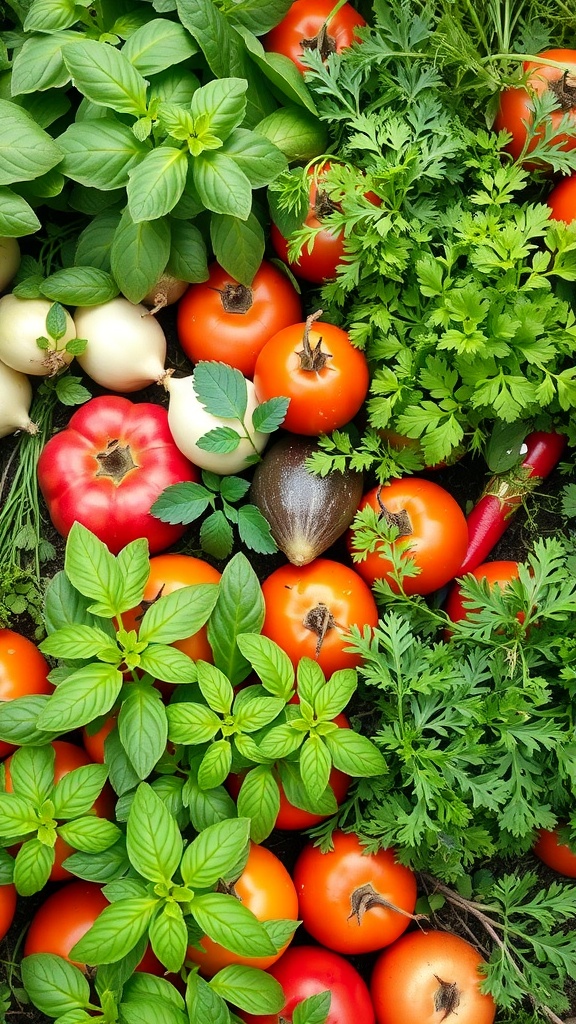
Herbs can bring a burst of flavor and aroma to your vegetable garden. Imagine walking through your backyard and being greeted by the fresh scents of basil, cilantro, and mint. These herbs not only enhance your meals but also add beauty to your garden.
In the image, you can see a vibrant mix of tomatoes, peppers, and fresh herbs. The lush green basil stands out among the ripe red tomatoes. This combination creates a lively and inviting space. Planting herbs like basil and cilantro alongside your vegetables can help attract beneficial insects and improve growth.
When planning your garden, think about companion planting. Herbs can protect your vegetables from pests and diseases. For example, basil is known to repel certain insects that might harm tomatoes. This natural method can lead to a healthier garden without relying on chemicals.
Don’t forget to harvest your herbs regularly. This encourages new growth and keeps your plants thriving. You can use fresh herbs in your cooking, making your dishes more flavorful. Plus, having fresh herbs on hand is a great way to impress your family and friends.
Using Raised Beds for Better Soil Management

Raised beds are a fantastic way to manage soil in your backyard vegetable garden. They offer better drainage and can be filled with high-quality soil, which is essential for healthy plants. The image shows a vibrant garden filled with leafy greens and other vegetables, all thriving in neatly arranged raised beds.
These beds help keep the soil loose and aerated. This is important for root growth and allows plants to access nutrients more easily. You can see how the plants in the image are lush and green, indicating they are getting the care they need.
Another benefit of raised beds is that they can be built to a comfortable height. This makes gardening easier on your back and knees. Plus, they can be placed in sunny spots, ensuring your veggies get enough light. The garden in the picture looks well-organized, making it easier to tend to each plant.
Using raised beds also helps with weed control. The defined borders keep weeds at bay, allowing your vegetables to flourish without competition. The variety of greens in the image shows how diverse your garden can be, from leafy greens to other vegetables.
Overall, raised beds are a smart choice for anyone looking to improve their gardening experience. They provide a controlled environment that can lead to a bountiful harvest.
Watering Strategies for Optimal Growth
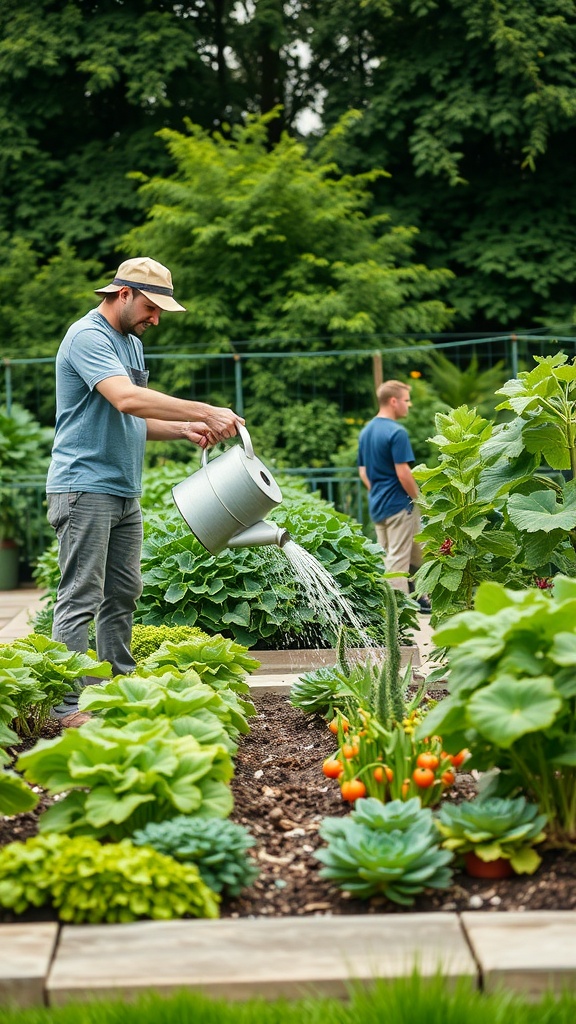
Watering is key to a thriving backyard vegetable garden. In the image, a person is watering a lush garden filled with various vegetables. The vibrant greens and bright oranges show the potential of a well-cared-for garden.
One effective strategy is to water deeply and less frequently. This encourages roots to grow deeper into the soil, making plants more resilient. Aim for about an inch of water per week, adjusting based on rainfall.
Another tip is to water in the early morning or late afternoon. This helps reduce evaporation and allows plants to absorb moisture better. Avoid watering during the hottest part of the day, as this can lead to waste.
Using a watering can, like the one in the image, allows for more control over how much water each plant receives. This is especially helpful for delicate seedlings that need gentle care.
Lastly, consider using mulch around your plants. Mulch helps retain moisture in the soil and can reduce the frequency of watering. It also suppresses weeds, giving your vegetables more room to grow.